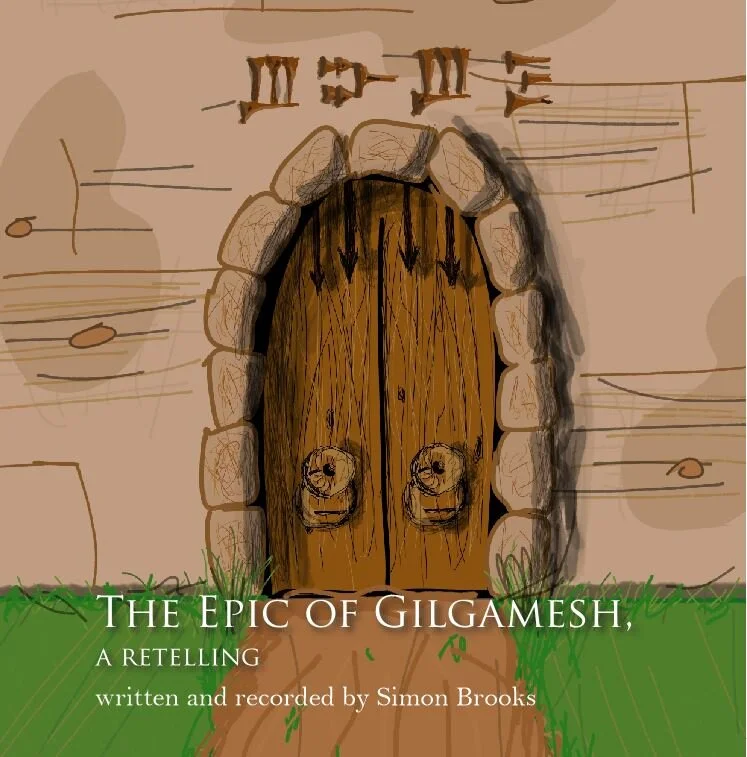The Epic of Gilgamesh
The epics are built from rock, fire and sea, blood and flesh and Gilgamesh is no exception; coming from ‘deep time’. Although the Sumerian epic of Gilgamesh was written on clay tablets around 3,500 years ago, the rediscovered clay fragments were unknown to the Western World until the mid-1800’s when they were found by the English archaeologist Austen Henry Layard. The first English translation was made in the 1870’s by George Smith. This amazing story is often taught at sixth grade level and into high school and college. The content of the tale is brutal in places, and there are sections which include sex. Some versions of the story published for middle and high schools are greatly simplified, have important sections removed and parts added which has meant losing the human condition of the story, and a level of authenticity.
As both my own children read and studied the epic at school, as a storyteller I found the versions they were learning from fell short and/or were inaccurate. Working with Social Studies and Language Arts teachers (and my, then, eleven-year-old daughter) I created what I consider an authentic retelling of Gilgamesh. Using two translations taken directly from the cuneiform, and two other books which used other tranlations, I wrote a version that is true to the original work, whilst making it appropriate for middle school students. I also conclude some presentations with a number of activities which are included for use in the classroom for school age children in PDF form. I returned the human condition of the tale. The PDF is available on Teachers Pay Teachers.
I recorded an audio version of the story in November 2017 and the following April it won a Gold Award from Parent’s Choice. Told in an exciting and engaging way, it is designed to draw students in and interest them not just in this epic, but others. This version encourages young people to find other epics and sagas such as Beowulf, the Iliad, and the Volsungs. It has been called one of the most accessible retellings of Gilgamesh.
I perform this story live and work with students on a series of activities which are designed to complement Social Studies and Language Arts curriculum and common core standards. This can be completed with a single class as a half, or full day school visit depending on activities.
People have asked me why I tell Gilgamesh. When it is taught in schools, sometimes as part of a high school course, and sometimes for Social Studies and Ancient Civilizations, it is often watered down. Sometimes these written tellings can be dry. The audience gets brought into the story when they hear it told, they get involved in the story, and this is why I tell the version I do, taken from sources close to the original cuneiform.
Note from an adult fan: “Gilgamesh was great. I loved how, just with a slight tone of voice, saying his same words over, you let me know he had changed by the end.
I was sorry when it was over. Makes me want to go and read the print version.”
- Jane
Mission accomplished! I hope you too fall in love with the story as much as I did.
The Epic of Gilgamesh, a retelling by Simon Brooks, illustrated by Aidan Brooks, copyright 2017
Introduction and Part One
The introduction gives a little background and history of the epic and lists the resources I used. It also provides the setting geographically and a brief summary of the story.
Part One tells of the tyranny of Gilgamesh and his meeting of Enkidu.
Part Two
Gilgamesh decides to invade the Cedar Forest. There he and Enkidu slay Humbaba. Gilgamesh insults the goddess Ishtar, and the king and his companion have to face the Bull of the Heavens.
Part three
A terrible punishment is handed out to Gilgamesh prompting him to search for immortality. He crosses the Waters of Death, and returns to his kingdom of Uruk humbled.
In the book form (PDF at this point) there is a list of the characters and who and what they are, a lexicon/vocabulary list, a resource list and series of activities.
On the 4th August, 2019 I was alerted by Sebastian Lockwood, fellow Brit and Gilgamesh fan, that there is a fascinating piece on the ark of the epic of Gilgamesh. It is available to view on YouTube: https://www.youtube.com/watch?v=s_fkpZSnz2I
It is illuminating and humorous at times and well worth a watch even at close to an hour long. And very interesting for social studies people.
More recently, after a ‘missing’ Babylonian tablet was discovered, another translation came out. Gilgamesh, by Sophus Helle, Yale University Press, 2021 is a superb work, and I highly recommend you take a look at it, especially if you have read other translations.



